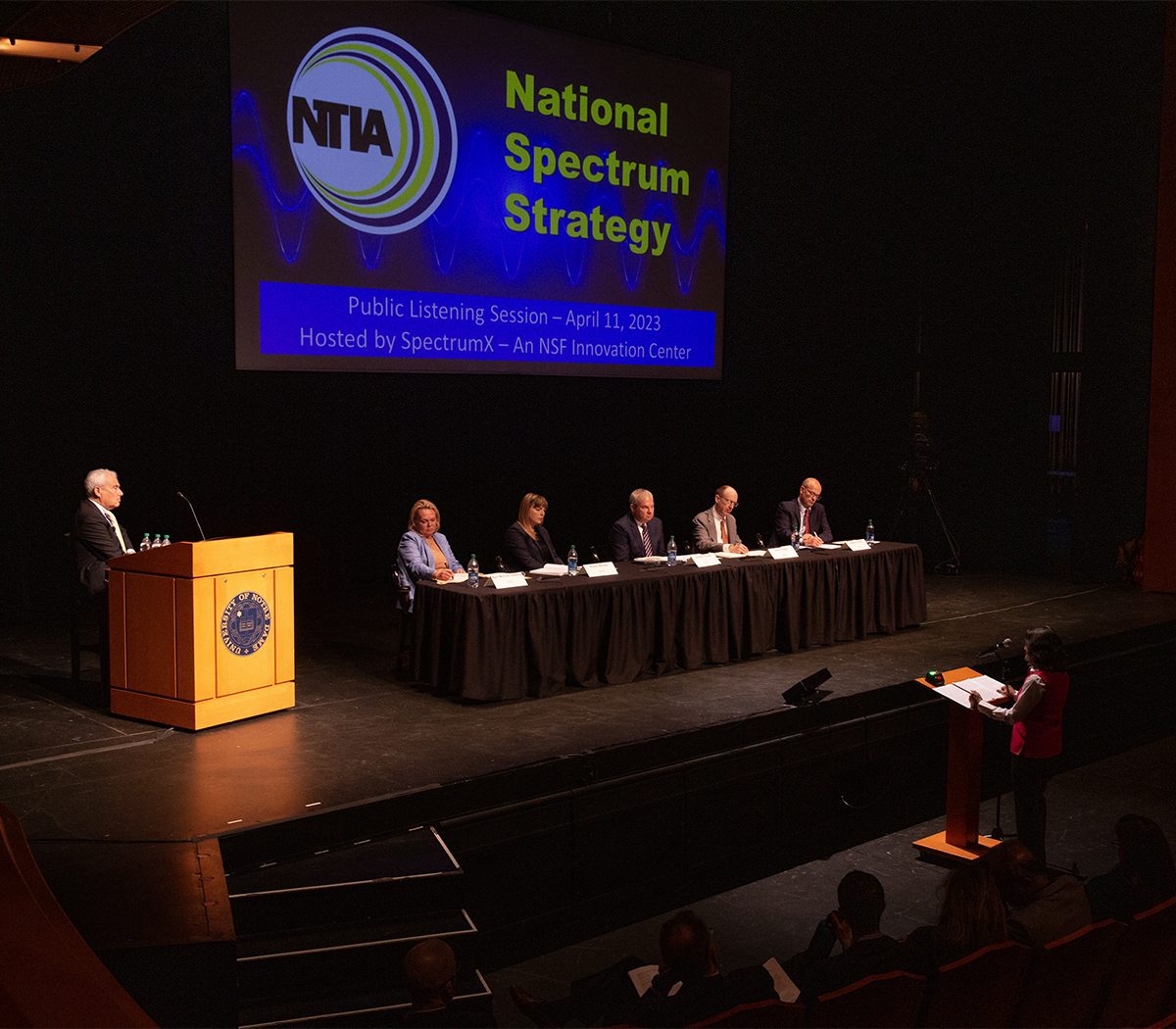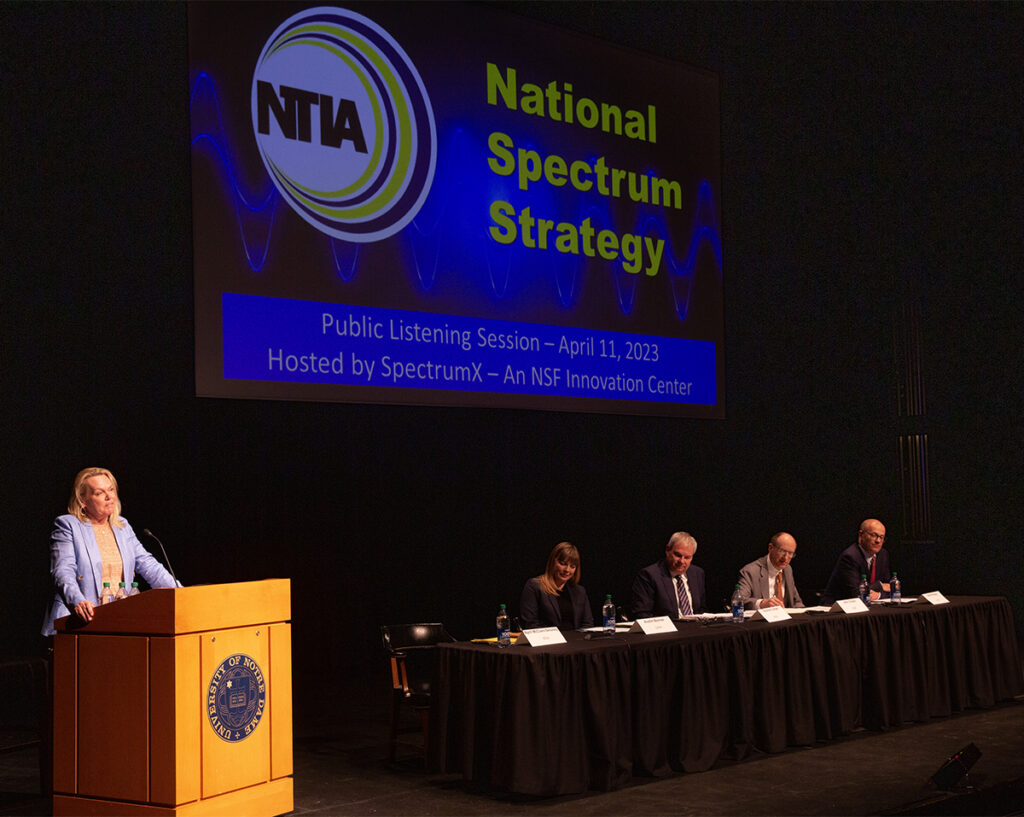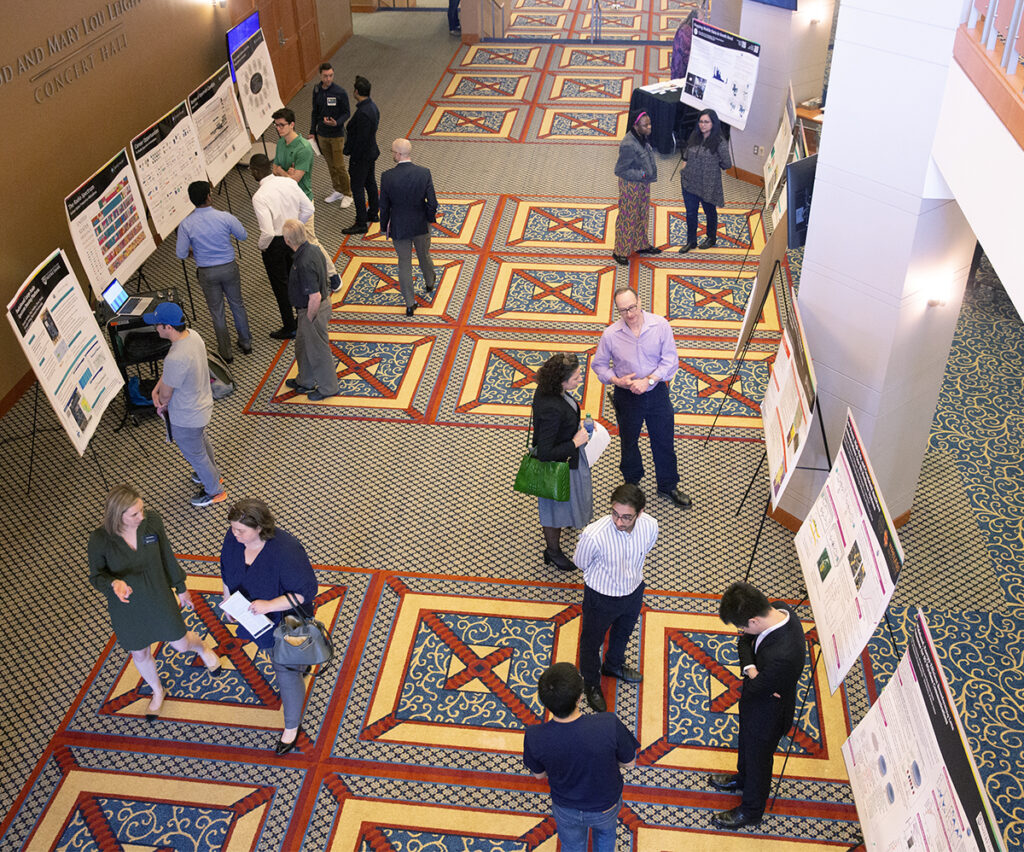Federal government hears comments on National Spectrum Strategy at listening session hosted by SpectrumX at Notre Dame

By Christina Clark
Photography by Wes Evard, University of Notre Dame
The University of Notre Dame’s DeBartolo Performing Arts Center became a national stage to host discussions on the formation of the U.S. National Spectrum Strategy on April 11, 2023. City employees, corporate representatives, trade associations and university researchers gave their input at the second of two National Telecommunications and Information Administration (NTIA) Listening Sessions.
Access to the radio spectrum is limited and demand for such access continues to grow. One of the NTIA’s goals in the National Spectrum Strategy is to identify 1500 MHz or more of spectrum to study for possible repurposing in the future. The two listening sessions allowed individuals concerned with spectrum allocations to submit their comments and findings ahead of the strategy’s formation.
“The NTIA wanted to go outside of the Beltway [Washington, D.C.] and hear from people across the country,” said April McClain-Delaney, Deputy Assistant Secretary of Commerce for Communications and Information. “We thought this was a good location at a university, particularly one that has a lot of students.”
The listening session was moderated by Scott Blake Harris, Director of the National Spectrum Strategy for the NTIA. Speakers stood at a podium and gave their comments to a panel of federal spectrum experts who could, in turn, ask questions. The panel included:
- April McClain-Delaney, Deputy Assistant Secretary of Commerce for Communications and Information, NTIA
- Austin Bonner, Assistant Director for Spectrum and Telecom Policy, Office of Science and Technology Policy, Executive Office of the President
- Charles Cooper, Associate Administrator, Office of Spectrum Management, NTIA
- Derek Khlopin, Deputy Associate Administrator for Spectrum Planning and Policy, Office of Spectrum Management, NTIA
- John Chapin, Special Advisor for Spectrum at the National Science Foundation

More than 50 people attended the public listening session in the Patricia George Decio Theatre. The event also was live streamed by the NTIA, and is available on YouTube, where more than 500 people have watched so far.
Denise Linn Riedl, Chief Innovation Officer for the City of South Bend, spoke on behalf of how cities and municipalities should be considered as the NSF, NTIA, Federal Communications Commission (FCC), consider writing the National Spectrum Strategy.
“Cities can stand up pilots relatively quickly, collaborate with universities like we do in South Bend with SpectrumX, and turn that into transferable lessons that can shape policy. Please leverage this natural strength of local governments,” Riedl said. “In South Bend, we like to refer to ourselves as a ‘beta city’ because we are not afraid to challenge established processes or pilot new technology that might generate public value for our residents.”
Faculty members from Notre Dame who provided comments included Nick Laneman, Center Director of the event’s official host, SpectrumX – a National Science Foundation (NSF) Spectrum Innovation Center, co-Director of Notre Dame’s Wireless Institute, and Professor of Electrical Engineering. Monisha Ghosh, SpectrumX Policy Outreach Director and Professor of Electrical Engineering, spoke about the difficulties faced by those trying to make innovations within the spectrum.
“One of the things I feel very strongly about is that the wireless ecosystem lacks the startup culture that we have in software. Part of it is our spectrum policies, the hurdles to get spectrum allocation are too high, getting hardware to build in a new spectrum band is very difficult,” said Ghosh. “If you can break down these barriers, in all of these different spaces that we have, I think we will get a lot more innovation in our wireless ecosystem than we have now.”
Laneman said, “I believe that a key component to the success of the National Spectrum Strategy, and its implementation plan, will be a paradigm shift in both the coordination of research and development, as well as workforce development activities related to wireless technologies and spectrum management. In particular, I believe the U.S. should create a National Coordination Office, or NCO, for Spectrum Innovation in the White House to proactively and holistically drive these two critical activities across government agencies, industry, and academia.”
Speakers continued to give comments through the afternoon and were from broad backgrounds, including:

- AT&T
- Ericsson
- Lockheed Martin Corporation
- National Spectrum Consortium
- Olin College
- SpectrumX
- Stanford University
- Ultra-wideband (UWB) Alliance
- University of Illinois Chicago
- University of Michigan
- U.S. Cellular
- Verizon
- Wireless Infrastructure Association
The event opened with a presentation given by Laneman that gave a primer for national spectrum challenges and innovations as the audience gathered for the session to begin.
Following Laneman, Robert J. Bernhard, Notre Dame’s Vice President of Research and Professor of Aerospace and Engineering, said in his welcoming remarks, “As an engineer myself, I recognize that the radio spectrum is basic to many of the modern advances we see today, including telecommunications, navigation, environmental sensing, defense, public safety, broadcasting, and others. But we can see limits to its future availability, so solutions must be found. This forum provides all of us an opportunity to assist in developing a national spectrum strategy.”
“From an individual, consumer, corporate, national security perspective, and also from a government perspective, we are all dependent on it [spectrum]. We’re an ecosystem, and we have to work together to figure out how to serve all of those needs,” McClain-Delaney said.
The NTIA’s next steps include reviewing the comments given for the formation of the National Spectrum Strategy through the listening sessions as well as a Request for Comments, which remained open through April 17, 2023.
For those wishing to review the NTIA Listening Sessions, the recordings are available at the NTIA’s Listening Sessions website: https://ntia.gov/issues/national-spectrum-strategy/listening-session
About SpectrumX
SpectrumX is funded by the National Science Foundation (NSF) as part of its Spectrum Innovation Initiative, under grant number AST 21-32700. SpectrumX is the world’s largest academic hub where all radio spectrum stakeholders can innovate, collaborate, and contribute to maximizing social welfare of this precious resource.
To learn more about SpectrumX, please visit spectrumx.org.
Contact:
Christina Clark, Research Communications Specialist
SpectrumX / Notre Dame Research / University of Notre Dame
cclark26@nd.edu / 574.631.2665
spectrumx.org